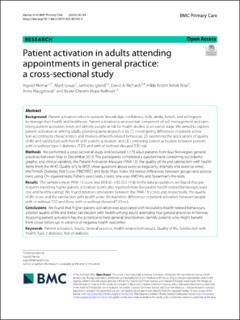| dc.contributor.author | Hernar, Ingvild | |
| dc.contributor.author | Graue, Marit | |
| dc.contributor.author | Igland, Jannicke | |
| dc.contributor.author | Richards, David A | |
| dc.contributor.author | Riise, Hilde Kristin Refvik | |
| dc.contributor.author | Haugstvedt, Anne | |
| dc.contributor.author | Kolltveit, Beate-Christin Hope | |
| dc.date.accessioned | 2023-12-18T11:35:01Z | |
| dc.date.available | 2023-12-18T11:35:01Z | |
| dc.date.created | 2023-07-27T13:09:16Z | |
| dc.date.issued | 2023 | |
| dc.identifier.citation | BMC Primary Care. 2023, 24 (1), . | en_US |
| dc.identifier.issn | 2731-4553 | |
| dc.identifier.uri | https://hdl.handle.net/11250/3108004 | |
| dc.description.abstract | Background Patient activation refers to patients’ knowledge, confidence, skills, ability, beliefs, and willingness to manage their health and healthcare. Patient activation is an essential component of self-management and identifying patient activation levels will identify people at risk for health decline at an earlier stage. We aimed to explore patient activation in among adults attending general practice by (1) investigating differences in patient activation according to characteristics and markers of health-related behaviour; (2) examining the associations of quality of life and satisfaction with health with patient activation; and (3) comparing patient activation between persons with or without type 2 diabetes (T2D) and with or without elevated T2D risk. Methods We performed a cross-sectional study and recruited 1,173 adult patients from four Norwegian general practices between May to December 2019. The participants completed a questionnaire containing sociodemographic and clinical variables, the Patient Activation Measure (PAM-13), the quality of life and satisfaction with health items from the WHO Quality of Life-BREF, three questions about exercise (regularity, intensity and exercise time), the Finnish Diabetes Risk Score (FINDRISC) and Body Mass Index. We tested differences between groups and associations using Chi-squared tests, Fisher’s exact tests, t-tests, one-way ANOVAs and Spearman’s rho tests. Results The sample’s mean PAM-13 score was 69.8 (0–100) (SD 14.8). In the total population, we found that participants reporting higher patient activation scores also reported more favourable health-related behaviours (exercise and healthy eating). We found positive correlations between the PAM-13 scores and, respectively, the quality of life score and the satisfaction with health score. We found no differences in patient activation between people with or without T2D and those with or without elevated T2D risk. Conclusions We found that higher patient activation was associated with favourable health-related behaviours, a better quality of life and better satisfaction with health among adults attending four general practices in Norway. Assessing patient activation has the potential to help general practitioners identify patients who might benefit from closer follow-up in advance of negative health outcomes. | en_US |
| dc.language.iso | eng | en_US |
| dc.publisher | BioMed Central | en_US |
| dc.rights | Navngivelse 4.0 Internasjonal | * |
| dc.rights.uri | http://creativecommons.org/licenses/by/4.0/deed.no | * |
| dc.title | Patient activation in adults attending appointments in general practice: a cross-sectional study | en_US |
| dc.title.alternative | Patient activation in adults attending appointments in general practice: a cross-sectional study | en_US |
| dc.type | Peer reviewed | en_US |
| dc.type | Journal article | en_US |
| dc.description.version | publishedVersion | en_US |
| dc.rights.holder | © The Author(s) 2023 | en_US |
| dc.source.pagenumber | 12 | en_US |
| dc.source.volume | 24 | en_US |
| dc.source.journal | BMC Primary Care | en_US |
| dc.source.issue | 1 | en_US |
| dc.identifier.doi | 10.1186/s12875-023-02102-9 | |
| dc.identifier.cristin | 2163785 | |
| dc.source.articlenumber | 144 | en_US |
| cristin.ispublished | true | |
| cristin.fulltext | original | |
| cristin.qualitycode | 1 | |

